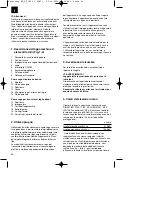
5. Technical data
AC motor
230 V ~ 50 Hz
Rating 1800
W
Idle speed n
0
4200 rpm
Carbide saw blade
Ø 250 x Ø 30 x 3.0 mm
Number of teeth
60
Weight 35
kg
Dust extraction connector
Ø 36 mm
For use as a crosscut and miter saw
Swiveling range
Up to 45° to the left
Miter cut
+45° / 0° / -45°
Saw width at 90°
65 x 155 / 23 x 200 mm
Saw width at 45° (turntable) 65 x 155 / 23 x 200 mm
Saw width at 45° (angle)
40 x 155 mm
Saw width at 2 x 45° (double miter cut) 40 x 105 mm
For use as a bench circular saw
Size of bench
540 x 500 mm
Max. cutting height
70 mm
Height adjustment
0 - 70 mm infinite
Tilting saw blade
0° - 45° to the right
6. Before starting
Pull the power plug before performing any
adjusting, conversion and assembly work.
앬
The machine has to be set up where it can stand
securely.
앬
All covers and safety devices have to be properly
fitted before the machine is switched on.
앬
It must be possible for the blade to run freely.
앬
When working with wood that has been
processed before, watch out for foreign bodies
such as nails or screws, etc.
앬
Before you press the ON/OFF switch check that
the saw blade is fitted correctly and that moving
parts move easily.
앬
Before you connect the machine to the mains
supply make sure that the data on the model
plate are identical to the mains data.
6.1 Installing and transporting the machine
(Fig. 3 – 6)
1.
Lift the machine out of the packaging and place it
on a flat surface with the saw bench (2) at the
bottom (Fig. 3).
2.
Unfold the base frame (6). To do this, undo the
knurled nuts (21), unfold the legs (6) and secure
them with the knurled nuts (21) (Fig. 4).
3.
Turn the machine over and place it on the base
frame (6). If the surface is not flat, the machine
can be made secure using the two adjustable
feet (22) (Fig. 5).
4.
Screw the two cable hooks (23) to the left-hand
side of the machine (Fig. 6).
5.
The front legs (6) can be extended to transport
the machine. The machine can now be
transported like a wheelbarrow using the front
legs (6) as handles.
7. Operation
7.1 Crosscut and miter saw
7.1.1 Conversion work for use as a crosscut and
miter saw
1. The saw is set up for use as a bench circular saw.
2. If necessary remove the angle and parallel stop
(see 7.2.2) and the saw blade guard (see
7.2.1/11).
3. Turn the knurled screw (Fig. 1 / Item 13) as far as
possible clockwise to move the saw blade to its
lowest position.
4.
Install the chip box (20). First attach it to the two
lugs than secure it to the saw bench (2) using the
screw (Fig. 7).
5.
Push the lever (Fig. 8 / Item 24) and carefully
swing the saw over (Fig. 8 – 10).
Important. When you swing the saw bench, there
is a risk of suffering crush injuries to your hands
and finger. Only touch the saw bench at the front
and rear when swinging it. Do not reach between
the saw bench and the side parts. Hold the
bench securely as you swing it. Ensure that the
lever engages fully again after you have swung
the saw bench and that the bench is locked into
position.
6. Push the machine head (17) downwards using
the handle (Fig. 1 / Item 16) while pulling out the
locking pin (Fig. 16 / Item 25) for the height
adjustment and turning it clockwise through an
angle of 90° (Fig. 11-12).
Important. The integral resetting springs will
automatically lift the machine head. Do not
immediately let go of the handle (Fig. 1 / Item 16)
after cutting, but allow the machine head (17) to
GB
22
Anleitung RT_FF_1825_U_SPK1:_ 23.06.2008 9:42 Uhr Seite 22






























